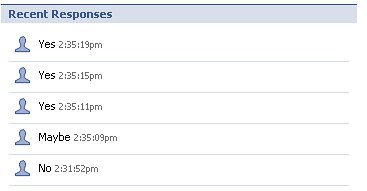A little while ago, I was lucky to catch a Facebook poll, as a way of advertising its new poll feature. As a follow up from that experience, I thought I might purchase my own poll to validate its effectiveness. Here are a few of my observations:
1) Answers appear to be clustered
One of the interesting things about the poll feature, is that it is real time. You are getting answers as people vote. You select what type of people you want to target, and Facebook will then quiz users of that criteria by putting the poll on their homescreen. Something I noticed however, was that answers seemed to come in together followed by a gap. I also noticed that these answers that come in groups, usually have similar responses.

I appears that users are highly responsive to a poll. If it appears on their survey, a lot of people appear to answer it. I know this because I specifically targeted my poll to Australians, in the middle of the day when I wouldn’t expect people to be using facebook.
The placing of the options seems to affect the results. I suppose anyone that has studied polling before, would probably know the order of a ballot heavily influences the poll. This appears evident here. Usefully however, Facebook allows you to randomise the poll so that different users see a different order. However as is demonstrated above, with this clustering, its groups of users that see a different order, not individuals
2) Facebook users appear to be more male, and younger
Something I noticed in my previous blog posting on the poll feature, was that there appeared to be more males answering. This seems to have happened occur with this poll as well, and indicates to me that Facebook’s population of users have a higher male base – which is unusual given that women generally outnumber men in society.
It should also be noted that there is no age groups option for people above 50 years old.
3) Takers of the poll appear to be a genuinely random population
The reason I picked 200 people, was that that is the minimum amount a poll needs to be before it can statistically be considered accurate to represent a population. However as I was able to obtain data as the poll was running, it gave me insight into how random (and representative) the population that took the test was.
Below is a screenshot half way through, as well as the final result
The results for the poll are almost identical. Without reading too much into it, that tells me the conditions of the test were genuinely random.
There are a few other things I noticed, but this isn’t me trying to promote a Facebook service, and will leave to make your own analysis in combination with the other Facebook poll I blogged about. I just want to highlight that for absolutely nothing, you can get an insight into a market in literally hours.
IBM recently released a report saying that the Internet has overtaken TV, changing the dynamics of the advertising industry, and that they see the role of advertising agencies in the future to go “beyond traditional creative roles to become brokers of consumer insight”
Facebook is an amazing company because of the amount of data it holds about the population in various societies. And for a fee – the rest of the world can take advantage of this as well. Welcome Facebook – the world’s most competitive agency for consumer insight.



